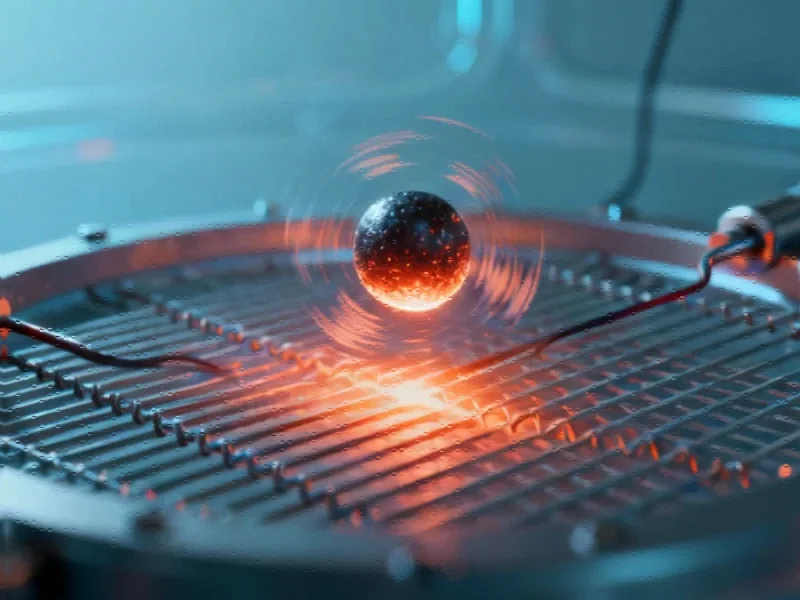The Nano-Engine Revolution
In a stunning demonstration of quantum-scale engineering, physicists have created what may be the most extreme microscopic engine ever conceived—achieving temperatures surpassing the Sun’s corona while occupying less space than a single cell. This breakthrough not only challenges our fundamental understanding of thermodynamics but opens unprecedented possibilities for simulating biological processes and advancing nanotechnology.
The experimental setup, detailed in an upcoming Physical Review Letters publication, represents a radical departure from conventional engine design. Rather than relying on combustion chambers or pistons, researchers at King’s College London engineered a system where a single microparticle levitates in near-perfect vacuum within an electromagnetic trap. When subjected to precisely controlled voltage fluctuations, this microscopic system demonstrated thermal behavior previously thought impossible at human scales.
Engineering the Impossible
“We’re operating in a regime where the normal rules of thermodynamics don’t always apply,” explained lead researcher Molly Message, whose team observed the engine fluctuating between extraordinary efficiency and apparent violations of established physical laws. The system achieved temperatures of 10 million Kelvins—approximately 18 million degrees Fahrenheit—making it significantly hotter than the Sun’s corona while being colder than the solar core.
What makes this engine particularly remarkable is its unpredictable behavior. During certain operational cycles, the power output actually exceeded input energy, while in others, the system cooled under conditions that should have generated additional heat. These anomalies, researchers suggest, point to quantum effects and statistical fluctuations that become dominant at microscopic scales.
Beyond Conventional Applications
While this microscopic engine won’t be powering vehicles or industrial equipment in the foreseeable future, its implications for research are profound. The same principles that enable this extreme thermal performance could revolutionize how we approach computational modeling of complex molecular interactions.
Senior author James Millen noted that these “odd thermodynamic behaviors” are completely natural at microscopic scales but counterintuitive from our macroscopic perspective. This disconnect highlights why traditional engineering approaches often fail when applied to nanoscale systems, and why new frameworks are needed to harness these phenomena effectively.
Practical Research Applications
The research team has identified several immediate applications for their microscopic powerhouse. Most promising is its potential to simulate protein folding—a process crucial to understanding diseases and developing pharmaceuticals. Current computer models struggle with the vastly different timescales involved in molecular dynamics, but this experimental approach offers a elegant solution.
“By observing the microparticle’s motion and deriving equations from that data, we bypass the computational limitations entirely,” explained co-author Jonathan Pritchett. This methodology could accelerate research across multiple fields, from materials science to educational technology development.
Broader Industrial Implications
While the immediate applications are research-focused, the underlying principles could eventually influence multiple sectors. The ability to control energy conversion at microscopic scales might lead to more efficient energy systems and novel approaches to heat management in compact electronics.
Furthermore, as industries increasingly embrace miniaturization and quantum technologies, understanding these extreme microscopic behaviors becomes essential for future industry developments. The research demonstrates that sometimes the most significant advances come from exploring systems that operate far outside conventional parameters.
Future Directions
The research team plans to continue refining their microscopic engine while exploring its potential for solving other challenging scientific problems. As related innovations in nanotechnology advance, such extreme microscopic systems may become increasingly important tools for both fundamental research and practical applications.
What began as an investigation into the limits of thermodynamic behavior has evolved into a platform with potential applications across physics, biology, and engineering. As Message concluded, “By mastering thermodynamics at this fundamental level, we’re not just building better engines—we’re developing new ways to understand and interact with the microscopic world that surrounds us.”
This article aggregates information from publicly available sources. All trademarks and copyrights belong to their respective owners.
Note: Featured image is for illustrative purposes only and does not represent any specific product, service, or entity mentioned in this article.



